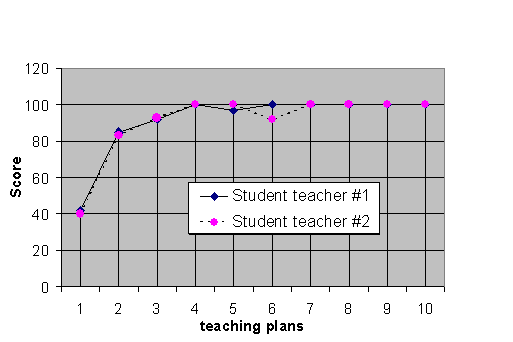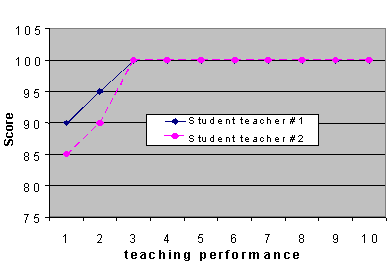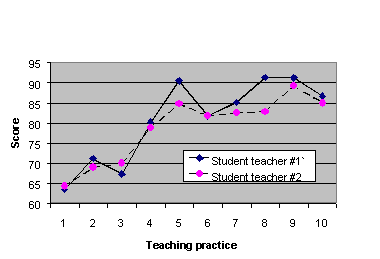

ACTION RESEARCH TO IMPROVE STUDENT TEACHERS’ ABILITY
TO USE INNOVATIVE INSTRUCTION IN A PHYSICS CLASSROOM
IN INDONESIA
Sa’adah Ridwan,
The State Junior High School #12, Bandung-West Java , Indonesia
Dr. Kardiawarman,
Indonesian University of Education , Bandung-West Java , Indonesia
Introduction
The field experience course at the State University of Bandung in Indonesia is one of the mandatory courses for education students in order to finish their teaching certification. The aim is to give them practical knowledge and experience of teaching-learning practices in the schools. In a pilot study for this research that included classroom observations, we found that the student teachers tended to avoid using science laboratories and teaching aids. They preferred carrying out their teaching verbally. We found no evidence that they were using science laboratories or teaching aides in their teaching as was advocated in their university courses.
In the pilot study, the student teachers reported that many other university and personal responsibilities made it difficult for them to focus on preparations for their field experience teaching. They said that they did not have enough time to prepare science laboratories and teaching aids to be used in their teaching activities. Other students said that they did not yet understand how to develop science laboratories. The latter comments made us wonder if their hesitancy to include laboratories had more to do with feeling uncomfortable with laboratory demonstrations rather than with the time constraints. We also concluded that the current traditional supervision processes with the student teachers had not contributed to encouraging innovative teaching among the student teachers.
This research intended to explore ways to support student teachers to use science laboratories and teaching aids in their teaching. Furthermore, we tried to explore the influence of a collaborative clinical supervision model involving three-way conferences to improve the ability of the student teachers in using science laboratories and teaching aides.
Research Questions
The questions for this study were:
- How can the teacher and university supervisor improve student teachers’ ability to use science laboratories and teaching aids in the teaching of physics?
- How will the teacher and supervisor’s use of collaborative clinical supervision using three-way conferences to improve the quality and innovation of the student teachers’ instruction during their field experiences?
Literature Review
There were three literatures that informed this research (a) action research, (b) constructivist learning, and (c) clinical supervision.
The purposes and procedures of action research were important to this study. As a classroom teacher and university professor, we have given many presentations throughout Indonesia on action research. We believe that it can help teachers to become more reflective and innovative in their teaching. We have used ideas from Australia (Kemmis & McTaggart, 1988), from England (Elliott, 1991) and the United States (Hubbard & Power, 1993; Cochran-Smith & Lytle, 1993). The national curriculum and associated exams in our country often make Indonesian teachers feel like they have little autonomy in their classrooms. Research studies have shown that action research empowers teachers to make changes in their teaching and in their school (Burnaford, Fischer & Hobson, 2001, Christenson, 1997; Dana, 1995; Day, 1984; Zeichner, 1995). In our experience, we have found action research gives teachers a way to study their teaching and improve instruction even when they must follow mandated curricula.
In this study, we were influenced by social constructivist principles that guided the teaching strategies we encouraged our student teachers to use. It also guided the action research that Ms. Ridwan was doing in her classroom to model these teaching approaches and to demonstrate action research processes. We depended on two major tents of constructivism:
(a) that learners actively construct their own knowledge rather than receive performed information transmitted by others, and
(b) that classroom interactions, and classroom dynamics must change in order to provide opportunities for this kind of learning, curriculum emphasis (Green & Gredler, 2002; Schlechty, 1990).
In this particular study we encouraged student teachers to use laboratory demonstrations, collaborative student work, and discussions to teach physics. We thought this approach promoted social constructivist learning in the classroom.
In this study we experimented with a collaborative clinical supervision model to work with our student teachers. At the time of this study, this was a new approach to supervision that we learned from U.S. consultants visiting our university campus. Our model was collaborative because a classroom teacher and university professor shared the supervision responsibilities, not only working collaboratively with each other but also with the student teachers ( Johnston , 1997). We met with the student teachers individually and in a group. Our goal was to establish trust, develop collegiality, and promote reflection, the hallmarks of clinical supervision (Frieberg & Waxman, 1988; Kent, 2001; Wilkins-Canter, 1996). We worked to establish our roles as guides and helpers, rather than maintaining the predominant evaluator role of traditional supervision models (Kolan, Hawkes & Francis, 1993; McBridge & Skau, 1995). In our action research, we wanted to study our own actions with the student teachers to see whether it would help to support their efforts to use more innovative teaching in teaching physics in middle school students.
Research Context and Participants
This research was conducted at the State Junior High School (SLTPN) No.12 in Bandung . It was a collaborative project between a Science-Physics teacher at SLTPN 12 Bandung (Ms. Sa’adah Ridwan), a Physics Education lecturer (Dr. Kardiawarman ) in the Faculty of Mathematics and Science Education at the Indonesian University of Education (UPI), and two Physics student teachers doing their one-semester field experience at SLTPN 12 Bandung. The classes used in this study were the first and second levels of the second grade at this junior high school in the third semester of the 2000/2001 academic year.
Ms. Ridwan was using this action research project for her master’s thesis. It was the first action research thesis to be completed at UPI. Dr. Kardiawarman was her advisor. Together they have given many workshops on action research throughout Indonesia . In addition, students from UPI and teachers working on action research projects occasionally visit Ms. Ridwan’s classroom to see innovative teaching techniques that are the focus of the action research she continues to do in her classroom.
Observation Instrument
A protocol was constructed for observing the student teachers’ development of innovative teaching practices including the use of laboratory experiments and teaching aides. There were six categories and each category was given a score using agreed upon criteria:
- the opening session
- preparation for the science laboratory activities
- the science laboratories activities and data collection when teaching
- small group discussions following the laboratory demonstration
- class discussion
- closing session
Data Collection
The data collected for this study included:
- Observations of student teachers taken by classroom the teacher/researcher (Ms. Ridwan) and the university supervisor/researcher (Dr. Kariawarman ) using the observation form constructed for this study.
- Self-reflective journal of the classroom teacher related to her teaching practice and observation notes of her teaching by the university supervisor/researcher.
- Student teacher lesson plans.
- Reflective notes and audiotape transcripts of clinical supervision conferences.
Action Plan
The action plan for this project included (a) the student-teachers observed their classroom teacher’s (Ms. Ridwan) strategies for using demonstrations in her teaching; (b) the student-teachers and classroom teacher taught together in a “team teaching” model, (c) the student-teachers taught independently. A collaborative clinical supervision model was used throughout to encourage collaboration and dialogue.
Research Procedures
This research employed classroom action research and was divided into three cycles (a) a pilot study using conversations and observations with student teachers to identify the problems to be addressed in the action research, (b) an action plan using innovative methods to influence student teachers’ teaching and learning, and (c) the use of collaborative clinical supervision to support innovative teaching of the classroom teacher and the student teachers.
Research Findings
To address the research question, whether the teacher and university supervisor can improve student teachers’ ability to use science laboratories and teaching aids in the teaching of physics, we present our research findings related to planning, teaching, and student evaluations.
Planning
In Figure 1 we can see that the student teachers were very weak in constructing lesson plans that included innovative teaching approaches. During their first effort at making a teaching plan, the six aspects of teaching and learning were scored respectively at 1.6 and 1.7 (on a scale of 4) or 46% and 47%. The score is an average of the scores on the 6 criteria of the evaluation form. The weaknesses were mainly in the use of science laboratories and conducting discussions following the science laboratories. After conducting three-way conferences using collaboartive clinical supervision, their second teaching plan did not show this weakness to the same degree. The scores that they achieved were 3.3 and 3.4 or 83% and 85% respectively.

Figure 1. Student teachers’ achievement in teaching preparation
The primary weakness found in the third lesson plan was that they had not yet included real examples from the students’ daily life in their lesson plans. Processes for developing this in their next lesson were discussed in the clinical supervision conference. We discussed how such examples can be used to increase the curiosity of the students. The student teachers’ inability to use more child-centered teaching strategies may be the result of the ways in which they themselves were used to studying. They seemed to have only learn physics superficially and theoretically. Even though new strategies were demonstrated in their courses at the university, they had no personal learning experiences that helped them to understand the benefits of these new appraoches. They also did not have experiences with approaches that can be used to motivate students. After discussions in the clinical supervision conference, the student teachers’ ability to develop teaching preparation improved.
During the time in which these data on planning were collected, the student teachers were observing and assisting the classroom teacher to gain experience in using laboratory experiments and teaching aides. The support they were receiving then included both the observing and assisting in the teaching and conversations in the clinical supervision meetings.
Teaching
Data shown in Figure 2 were collected during the period in which the two student teachers were doing independent teaching. For their first lessons, they achieved respectively a score of 3.4 and 3.6 (on a scale of 4) or 85% and 90%. The data show that the two student teachers’ scores developed over the first three lessons and then maintained a high level as they did their independent teaching. The increases in their performances indicate their growing ability to teach using laboratory experiments and teaching aides.
Using the qualitative data analyses from the three-way conferences during the collaborative clinical supervision meetings, we found that the team teaching was influential in helping them develop the skills that they demonstrated in their independent teaching. One of the students commented: “I got so much benefit from the team teaching that I did not find any difficulties in facing my teaching duties.”

Figure 2. Student teachers’ achievement in independent teaching practice.
Student Evaluations
Figure 3 presents the data collected from the middle school students related to the student teachers’ teaching performance. The data show good improvement in their teaching from the students’ point of view. The students evaluated the student teachers’ performance using the same items on the clinical evaluation form (a) the opening session. (2) the process of preparing the science laboratory activities, (3) the main science laboratories activities and data collection, (4) the discussion in the small group, (5) class discussion, and (6) closing session. We can see that the students’ responses indicated average score 63% and 64% respectively for the two student teachers on the first lesson up to 91% and 91% respectively on their tenth lesson.

Figure 3. Evaluations of the student teachers by classroom students
Conclusions
Based on findings mentioned above we can conclude that the three-way conferences and clinical supervision increased these student teachers’ perfomance, particularly in conducting science laboratory activities for field experience program in SLPTN 12 Bandung, Indonesia. The implementaion of the three way conferences in the clinical supervision model and the observations and team teaching with the classroom teachers seemed sufficient to support students’ implementation of more innovative teaching techniques in physics.
Advantages of the Research
The research gave some benefits not only to each person that was involved but also to the institutions. The benefits for the student teachers included (a) they improved their knowledge and views about the types and the use of science laboratories, and (b) they increased their willingness and ability to use science laboratories in teaching and learning activities.
The benefits for the middle school students were readily observable. While this research focused primarily on the student teachers’ learning, all participants in the study agreed that the more interactive and hands-on environment (compared to traditional lecture methods) created more interaction and better relationships between student teachers and the middle school students, and that the students were more motivated and participated more fully in the learning activities and discussions.
The benefits for the teacher and the supervisor included (a) improving their knowledge and views about the types and uses of science laboratories by watching the implmentation of these methods by the student teachers, (b) increasing their experience and confidence with a collaborative clinical approach to supervision, and (c) improving the cooperation among the students, the student teachers, the teachers, the lecturer, the middle school, and the Indonesia University of Education/UPI.
The benefits for the school included (a) developing a basis for deciding effective approaches to be used to improve the services and cooperation in the field experience program, and (b) establishing collaboration between the school, the teacher, the student teachers, and UPI.
The benefits for UPI included (a) providing beginning research to inform broader policy development to improve the field experience program, (b) establishing collaboration with a school that could function as UPI’s laboratory for research and field experiences, (c) providing an example of how to connect science method courses with actual classroom practices, and last but not least, (d) improving the teaching abilities of the UPI Indonesia University of Education graduates.
References
Burnaford, G. E., Fischer, J., & Hobson, D. (Eds.). (2001). Teachers doing research. New York: Lawrence Erlbaum.
Christenson, M., & Serrao, S. (1997). Cooperative learning in a hostile environment. Teaching and Change, 4, 137-156.
Dana, N. (1995). Action research, school change, and the silencing of teacher voice. Action in Teacher Education, 16, 59-70.
Elliott, J. (1991). Action research for educational change. Philadelphia : Open University Press.
Freiberg, H., & Waxman, H. (1988). Alternative feedback approaches for improving student teachers' classroom instruction. Journal of Teacher Education, 39, 8-13.
Green, S. K., & Gredler, M. E. (2002). A review and analysis of constructivism for school-based practice. School Psychology Review, 31(1), 53-70.
Hopkins, D. (1992). A teacher guide to classroom research (2nd ed.). London : Open University Press.
Hubbard, R., & Power, B. (1993). Living the questions: A guide for teacher-researchers. Portsmouth , NH : Heinemann.
Johnston , M., & PDS colleagues (1997). Contradictions in collaboration: New thinking on school/university partnerships. New York : Teachers College Press.
Kemmis, S., & McTaggart, R. (Eds.). (1988). The action research planner (3rd ed.). Geelong: Deakin University Press.
Kent, S. (2001). Supervision of student teachers: Practices of cooperating teachers prepared in a clinical supervision course. Journal of Curriculum Studies, 16(3), 228-244.
McBridge, M., & Skau, K. G. (1995). Trust, empowerment and reflection: Essentials of supervision. Journal of Curriculum Studies, 10, 262-277.
Mills, G. E. (2000). Action research: A guide for the teacher research. Columbus , OH : Prentice Hall.
Nolan, J., Hawkes, B., & Francis, P. (1993). Case studies: Windows onto clinical supervision. Educational Leadership, 51, 52-56.
Schlechty, P. (1990). Schools for the twenty-first century. San Francisco : Jossey-Bass.
Wilkins-Canter, E. (1996). Providing effective cooperating teacher feedback. In J. McIntyre & D. Byrd (Eds.), Preparing tomorrow's teachers: The field experience. Thousand Oaks, CA: Corwin Press.
Zeichner, K. M., & Gore, J. M. (1995). Using action research as a vehicle for student teacher reflection. In S. E. Noffke & R. B. Stevenson (Eds.), Educational action research: Becoming practically critical (pp. 13-30). New York: Teachers College Press.
Further References for Indonesian Readers
Barus, P. K., and Purnomo Imam (1995), Fisika I dan II, Jakarta, Perum Balai Pustaka.
Departemen Pendidikan dan Kebudayaan (1994), Kurikulum SLTP 1994, Jakarta, Depdikbud RI.
Departemen Pendidikan dan Kebudayaan (1990), Pedoman penulisan darya tulis Ilmiah, Bandung, P2LPTK, IKIP Bandung.
Tim Pelatih Proyek PGSM (1999), Penelitian tindakan kelas, Jakarta, PGSM Dirjen Dikti, Depdikbud.
UPT PPL (2000), Panduan praktek kependidikan, Bandung, UPI
Biographical Note:
Sa’adah Ridwan is a physics teacher in a junior high school in Bandung , Indonesia . She reports here on her action research master’s thesis, which was the first action research project to be done in Indonesia for a master’s degree. She and her joint author regularly give action research workshops throughout Indonesia . She is also interested in democratic teaching and life skills education.
Ms. Ridwan can be reached at the State Junior High School #12 (SLTPN), Jl. Setiabudi No. 195, Bandung-West Java, 40153, Indonesia .
Dr. Kardiawarman is a professor at the State University of Bandung, Indonesia teaching courses in physics education and technology. He completed his PhD degree in the United States . He has done a lot of work at his university and throughout Indonesia related to action research for teachers.
Dr. Kardiawarman can be reached at the Physics Education Dept., Indonesian University of Education (UPI), Jl. Setiabudi No. 229, Bandung-West Jana, 40154, Indonesia .
